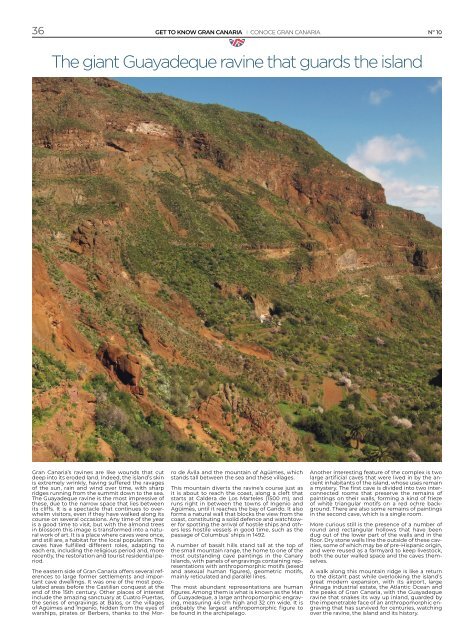No. 10 - Its Gran Canaria Magazine
Rutas, recomendaciones y noticias de Gran Canaria Routes, tips and news about Gran Canaria
Rutas, recomendaciones y noticias de Gran Canaria
Routes, tips and news about Gran Canaria
You also want an ePaper? Increase the reach of your titles
YUMPU automatically turns print PDFs into web optimized ePapers that Google loves.
36<br />
GET TO KNOW GRAN CANARIA I CONOCE GRAN CANARIA Nº <strong>10</strong><br />
The giant Guayadeque ravine that guards the island<br />
<strong>Gran</strong> <strong>Canaria</strong>’s ravines are like wounds that cut<br />
deep into its eroded land. Indeed, the island’s skin<br />
is extremely wrinkly, having suffered the ravages<br />
of the sun, rain and wind over time, with sharp<br />
ridges running from the summit down to the sea.<br />
The Guayadeque ravine is the most impressive of<br />
these, due to the narrow space that lies between<br />
its cliffs. It is a spectacle that continues to overwhelm<br />
visitors, even if they have walked along its<br />
course on several occasions. Any time of the year<br />
is a good time to visit, but with the almond trees<br />
in blossom this image is transformed into a natural<br />
work of art. It is a place where caves were once,<br />
and still are, a habitat for the local population. The<br />
caves have fulfilled different roles, adapting to<br />
each era, including the religious period and, more<br />
recently, the restoration and tourist residential period.<br />
The eastern side of <strong>Gran</strong> <strong>Canaria</strong> offers several references<br />
to large former settlements and important<br />
cave dwellings. It was one of the most populated<br />
areas before the Castilian conquest at the<br />
end of the 15th century. Other places of interest<br />
include the amazing sanctuary at Cuatro Puertas,<br />
the series of engravings at Balos, or the villages<br />
of Agüimes and Ingenio, hidden from the eyes of<br />
warships, pirates or Berbers, thanks to the Morro<br />
de Ávila and the mountain of Agüimes, which<br />
stands tall between the sea and these villages.<br />
This mountain diverts the ravine’s course just as<br />
it is about to reach the coast, along a cleft that<br />
starts at Caldera de Los Marteles (1500 m), and<br />
runs right in between the towns of Ingenio and<br />
Agüimes, until it reaches the bay of Gando. It also<br />
forms a natural wall that blocks the view from the<br />
coast, constituting a solid defence and watchtower<br />
for spotting the arrival of hostile ships and others<br />
less hostile vessels in good time, such as the<br />
passage of Columbus’ ships in 1492.<br />
A number of basalt hills stand tall at the top of<br />
the small mountain range, the home to one of the<br />
most outstanding cave paintings in the Canary<br />
Islands, with panels of engravings containing representations<br />
with anthropomorphic motifs (sexed<br />
and asexual human figures), geometric motifs,<br />
mainly reticulated and parallel lines.<br />
The most abundant representations are human<br />
figures. Among them is what is known as the Man<br />
of Guayadeque, a large anthropomorphic engraving,<br />
measuring 46 cm high and 32 cm wide. It is<br />
probably the largest anthropomorphic figure to<br />
be found in the archipelago.<br />
Another interesting feature of the complex is two<br />
large artificial caves that were lived in by the ancient<br />
inhabitants of the island, whose uses remain<br />
a mystery. The first cave is divided into two interconnected<br />
rooms that preserve the remains of<br />
paintings on their walls, forming a kind of frieze<br />
of white triangular motifs on a red ochre background.<br />
There are also some remains of paintings<br />
in the second cave, which is a single room.<br />
More curious still is the presence of a number of<br />
round and rectangular hollows that have been<br />
dug out of the lower part of the walls and in the<br />
floor. Dry stone walls line the outside of these cavities,<br />
some of which may be of pre-Hispanic origin,<br />
and were reused as a farmyard to keep livestock,<br />
both the outer walled space and the caves themselves.<br />
A walk along this mountain ridge is like a return<br />
to the distant past while overlooking the island’s<br />
great modern expansion, with its airport, large<br />
Arinaga industrial estate, the Atlantic Ocean and<br />
the peaks of <strong>Gran</strong> <strong>Canaria</strong>, with the Guayadeque<br />
ravine that snakes its way up inland, guarded by<br />
the impenetrable face of an anthropomorphic engraving<br />
that has survived for centuries, watching<br />
over the ravine, the island and its history.

















